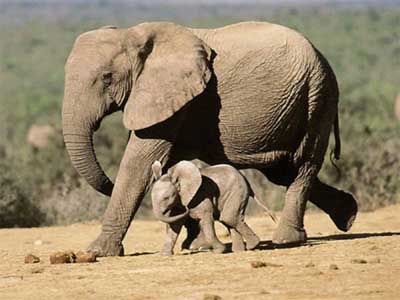
象,通称大象,是目前陆地上最大的哺乳动物,屬於长鼻目,只有一科两属三种,即象科(学名:Elephantidae),非洲象屬和象屬,非洲象有两种:普通非洲象(也叫热带草原象或灌木象)和非洲森林象,象屬只有亚洲象一种(也叫印度象)。广泛分布在非洲撒哈拉沙漠以南和南亚及东南亚以至中国南部边境的热带及亚热带地区。
象的妊娠期为22个月,刚出生的小象就有100千克重,需要8-14岁才能达到性成熟。
象皮厚毛少,鼻与上唇愈合成圆筒状长鼻,两个上颌门齿大而长,就是所谓的“象牙”,口中一般每侧有三个前磨牙和三个后磨牙,食用高纤维的食品,树叶、草类等,磨牙并不是同时长出,现存的磨牙磨损后,新的磨牙才长出来,所以如果最后一颗(第六颗)磨牙大约在60岁以后磨损后,老象可能死于营养不良,如果继续饲喂磨碎的食品,它有可能继续活下去。
Elephants are large mammals of the family Elephantidae and the order Proboscidea. Two species are traditionally recognised, the African elephant (Loxodonta africana) and the Asian elephant (Elephas maximus), although some evidence suggests that African bush elephants and African forest elephants are separate species (L. africana andL. cyclotis respectively). Elephants are scattered throughout sub-Saharan Africa, South Asia, and Southeast Asia. Elephantidae is the only surviving family of the order Proboscidea; other, now extinct, members of the order include deinotheres, gomphotheres, mammoths, and mastodons. Male African elephants are the largest extantterrestrial animals and can reach a height of 4 m (13 ft) and weigh 7,000 kg (15,000 lb). All elephants have several distinctive features the most notable of which is a long trunk or proboscis, used for many purposes, particularly breathing, lifting water and grasping objects. Their incisors grow into tusks, which can serve as weapons and as tools for moving objects and digging. Elephants' large ear flaps help to control their body temperature. Their pillar-like legs can carry their great weight. African elephants have larger ears and concave backs while Asian elephants have smaller ears and convex or level backs.
Elephants are herbivorous and can be found in different habitats including savannahs, forests, deserts and marshes. They prefer to stay near water. They are considered to bekeystone species due to their impact on their environments. Other animals tend to keep their distance; predators such as lions, tigers, hyenas and wild dogs usually target only the young elephants (or "calves"). Females ("cows") tend to live in family groups, which can consist of one female with her calves or several related females with offspring. The groups are led by an individual known as the matriarch, often the oldest cow. Elephants have a fission-fusion society in which multiple family groups come together to socialise. Males ("bulls") leave their family groups when they reach puberty, and may live alone or with other males. Adult bulls mostly interact with family groups when looking for a mate and enter a state of increased testosterone and aggression known as musth, which helps them gain dominance and reproductive success. Calves are the centre of attention in their family groups and rely on their mothers for as long as three years. Elephants can live up to 70 years in the wild. They communicate by touch, sight, smell and sound; elephants use infrasound, and seismic communication over long distances. Elephant intelligence has been compared with that of primates and cetaceans. They appear to haveself-awareness and show empathy for dying or dead individuals of their kind.
African elephants are listed as vulnerable by the International Union for Conservation of Nature (IUCN), while the Asian elephant is classed as endangered. One of the biggest threats to elephant populations is the ivory trade, as the animals are poached for their ivory tusks. Other threats to wild elephants include habitat destruction and conflicts with local people. Elephants are used as working animals in Asia. In the past they were used in war; today, they are often put on display in zoos and circuses. Elephants are highly recognisable and have been featured in art, folklore, religion, literature and popular culture.
No comments:
Post a Comment